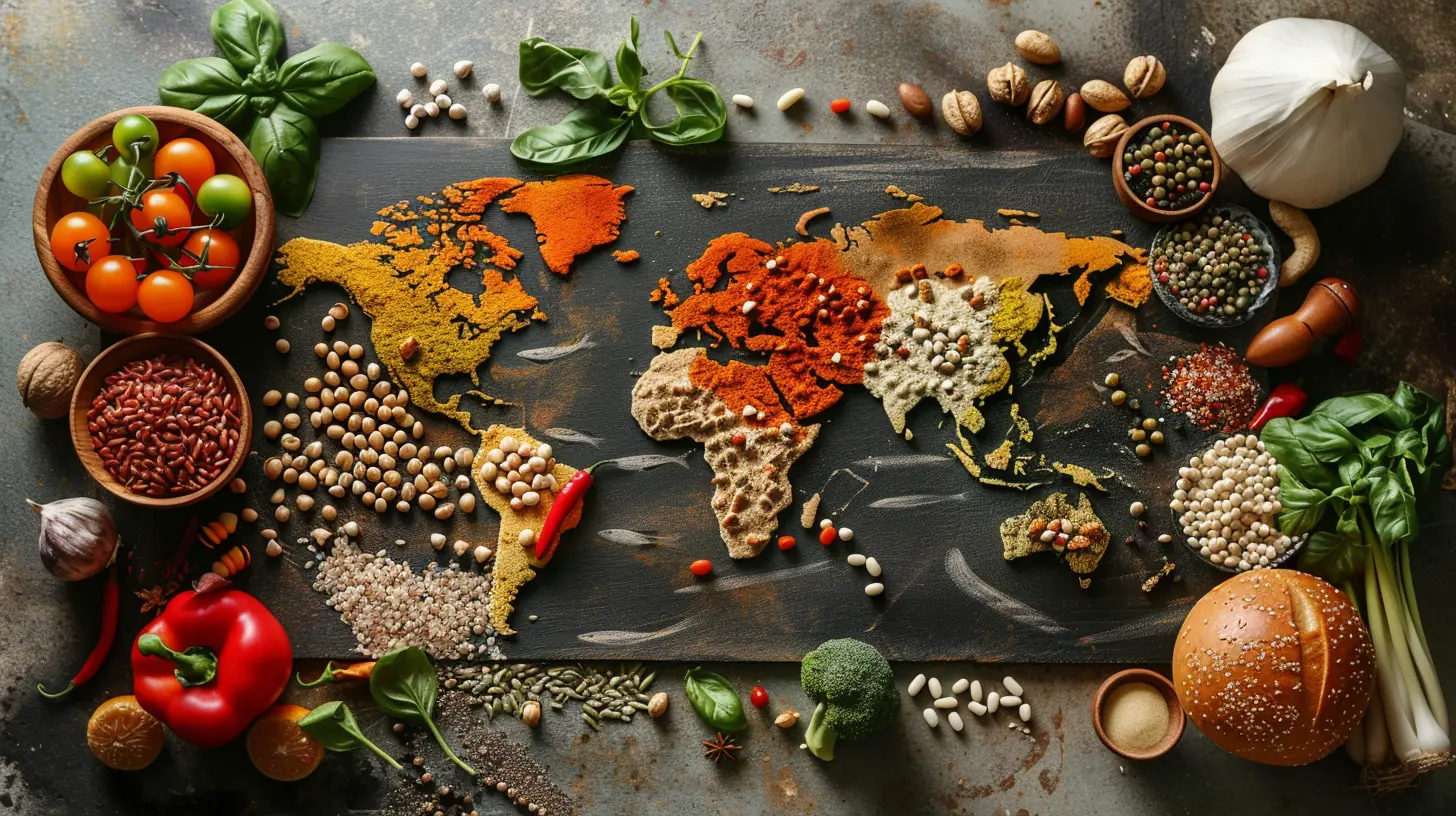Introducing Your Kids to Global Cuisines: A Fun Way to Expand Their Palates
8 August 2025
Are you tired of the same chicken nuggets and mac ‘n’ cheese on repeat? Yeah, we get it. It’s easy to fall into the food routine trap—especially with picky eaters in the house. But what if mealtime could be more than just a chore? What if it could be a passport to new cultures, flavors, and adventurous memories?
Introducing your kids to global cuisines is not just about food—it’s a fun, hands-on way to help them grow, both nutritionally and culturally. Plus, it beats arguing over one more uneaten green bean.
Let’s dive into the hows and whys of expanding your child's taste buds with foods from around the world, one delicious bite at a time.
Why Bother with Global Cuisines for Kids?
Food Is Culture, and Culture Is Cool
Food tells stories. Every dish has roots—history, traditions, and flavors passed down through generations. When you bring sushi to the dinner table or make tacos on a Tuesday, you're giving your kids a little world history lesson without the textbook.It’s like a cultural time machine on a dinner plate.
Develop Open-Minded Eaters
Let’s be real—kids can be picky. But picky eaters don't have to stay picky forever. By exposing your child to different cuisines early on, you’re helping them develop curiosity and flexibility when it comes to food. And trust me—that flexibility can spill over into other parts of life too.Trying new foods encourages bravery, open-mindedness, and a willingness to embrace the "different." Pretty powerful stuff from a bowl of pad Thai, huh?
When to Start: The Sooner, the Better
There’s no perfect age to begin introducing global flavors, but earlier is often easier. Toddlers are naturally curious and still forming their taste preferences. This is a prime time to sprinkle in new spices, textures, and dishes.Don’t worry if your child is older. It’s never too late! You just may need to use a little more creativity and patience. And that’s okay.
Tips for Making Global Cuisine Kid-Friendly
Alright, so, how do you actually pull this off without turning dinner into a battleground? Here are some parent-tested (and kid-approved) tips to smooth the process:1. Start Small and Familiar
Don’t jump straight into fermented tofu or raw octopus (unless your kid is a super champ). Start with familiar dishes that have an international twist.Examples:
- Tacos (Mexican) — Most kids love assembling their own!
- Pasta with Bolognese (Italian) — Change up the seasonings gradually.
- Teriyaki Chicken (Japanese) — Sweet and savory is usually a win.
You’re looking for a “bridge” food—something your kid already likes, but with a new element added in.
2. Let Them Help in the Kitchen
This is a game-changer. Kids are way more likely to try a new food if they helped make it. Let them mix, sprinkle spices, or even just wash veggies.Suddenly, your little one’s not just eating falafel—they’re the chef who made it happen. Pride makes food taste better. Science probably backs that up, but even if it doesn’t, it’s totally true.
3. Make It a Game or Theme Night
Turn mealtime into a mini adventure. Have a “Taste of Thailand Thursday” or “Moroccan Monday.” Play cultural music, put a flag on the table, and maybe even throw in a few fun facts.Kids love themes—and you’ll love how engaged they become.
4. Embrace the Power of Dipping
Let’s take a moment to recognize one universal truth: kids love to dip things. Whether it’s hummus, tzatziki, or peanut sauce, offering a dip can be the golden ticket to trying something new.Try cut-up naan with curry sauce or plantain chips with guacamole. It’s like their version of culinary training wheels.
5. Be Patient, Not Pushy
They won’t love everything. And that’s okay. The goal isn’t to force-feed them foreign dishes—it’s to introduce, spark curiosity, and normalize the idea that food from other cultures is not “weird,” just different.Keep trying. Repetition helps. And even one bite is progress.
10 Kid-Friendly Global Dishes to Get You Started
Need some inspiration? Here are ten global flavors that tend to get two tiny thumbs up:1. Japanese Chicken Teriyaki with Rice
Sweet, sticky, and oh-so-easy. Pair it with cucumber sushi rolls for bonus points.2. Italian Margherita Pizza
Cheesy and familiar—just add fresh basil to give it that authentic feel.3. Indian Butter Chicken with Naan
Mild and creamy. The sauce alone is often a big hit.4. Mexican Tacos with Ground Beef or Chicken
Let the kids pick their toppings—it’s DIY dinner made fun.5. Chinese Fried Rice
Use leftover rice and sneak in veggies. They won’t even notice!6. Greek Chicken Souvlaki with Tzatziki
Grilled chicken on a stick? Always a win. Plus, dipping sauce!7. Thai Peanut Noodles
Nutty and slightly sweet. Add thinly sliced carrots or cucumbers for crunch.8. French Crepes
Fill them with fruits, cheese, or even ham. Breakfast or dinner—your call.9. Korean Beef Bulgogi Bowls
Mildly sweet and savory. Serve with rice and chopped green onions.10. Middle Eastern Falafel and Hummus
Crispy on the outside, soft inside. Dunk it in hummus or wrap it in pita.Go Beyond the Plate: Make It a Full Cultural Experience
Food is the start—but why stop there?Watch a Movie From That Country
Make it a movie night! Watch a kid-friendly film from or about the country you’re "visiting" with your meal. This creates context and keeps the experience alive.Read a Picture Book or Story
There are amazing children’s books that introduce cultural themes, traditions, and lifestyles. Read before or after the meal for a whole-world experience.Learn a Word or Two in a New Language
Even learning how to say “thank you” or “hello” in a different language can be exciting. It shifts the focus from "eating weird food" to participating in something cool and global.Common Concerns: Let’s Address Those Real Quick
“My Kids Will Never Go for This.”
You might be surprised. The first time may not be a slam dunk, but children evolve. Keep offering, stay casual, and celebrate small wins. Even one bite deserves a high five.“But I Don’t Know How to Cook That Stuff.”
No worries! You don’t need to be a professional chef. Start with simple recipes, YouTube tutorials, or shortcut kits from international markets. Frozen gyoza or boxed tikka masala sauce can work just fine.“What If They Just Hate It?”
Honestly? That’s okay too. Not every dish will be a hit. You wouldn't love everything either. The key is exposure and building familiarity. Sometimes it takes 8–10 tries before kids warm up to a new food.Long-Term Benefits of Global Eating
Let’s zoom out for a sec. Why does this matter in the long run?- Cultural Awareness: Your kids become more empathetic and understanding of others.
- Social Confidence: They can navigate diverse environments with ease.
- Healthier Habits: A varied diet introduces different nutrients and flavor profiles, which can reduce sugar and processed food cravings.
- Curiosity & Courage: Trying new things at the table can translate into trying new things in life.
Final Thoughts: It’s Not Just About the Food
Introducing your kids to global cuisines is so much more than a culinary experiment. It’s a fun, flavorful way to open their hearts—and mouths—to the wonderful world around them.So go ahead, invite Italy into your kitchen next Friday or whip up some homemade dumplings on a snowy Sunday. Let your dinner table be the runway for their first trip around the globe.
Even if they turn up their nose at the kimchi, you’re still planting seeds of curiosity, respect, and adventure. And that? That’s something to toast to—preferably with a cold glass of mango lassi.
Bon appétit… or should we say, buen provecho, itadakimasu, or sahtein!
all images in this post were generated using AI tools
Category:
Kids NutritionAuthor:

Liam Huffman
Discussion
rate this article
1 comments
Cash Roberts
What a delightful idea! Introducing kids to global cuisines not only broadens their palates but also opens their minds to diverse cultures. Can't wait to try these fun recipes with my little ones!
August 16, 2025 at 2:45 AM

Liam Huffman
Thank you for your lovely comment! I'm thrilled to hear you're excited to explore global cuisines with your kids. Enjoy the culinary adventures!


